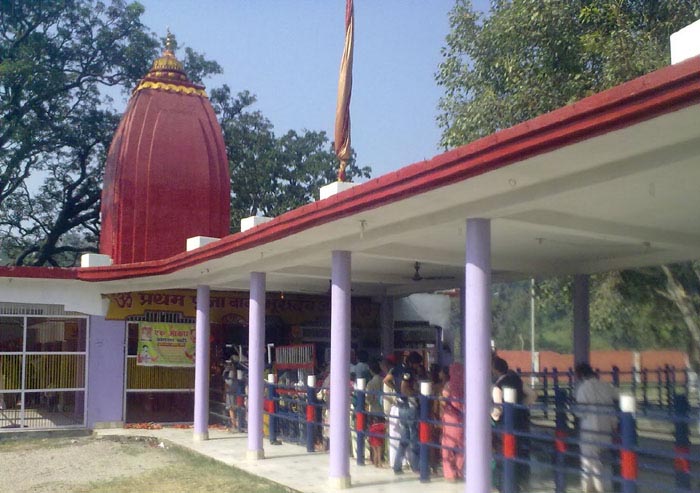Shakumbhari Devi Temple

Information of Shakumbhari Devi Temple, Saharanpur, Uttar Pradesh
Shakumbhari Devi Temple is an ancient temple which is visited by considerable number of devotee throughput a year. The temple is situated in Jasmour village of Saharanpur district of Uttar Pradesh. Shakumbhari Devi Temple is one of the 51 Shakti Peethas where portions of goddess Sati fell. It is said the head of goddess Sati fell in Shakumbhari Devi Temple and hence is considered as a quite religious place for Hindu.
Shakumbhari Devi Temple Religious Significance
One of the key characteristics of Shakumbhari Devi Temple is that the idol of Shakumbhariis specially worshipped during the period of Rahukala. Rahukala is regarded as an ominous time according to Hindu religion. It is believed that worshipping goddess Shakumbhari in this specific time can remove all adversities and problems in life. There is also significant flash of people in Shakumbhari Devi Temple particularly on Tuesday, Friday and Sunday because these days are regarded as favourable for worshipping the goddess. In this temple, prayers are thrown through illuminating various oil lamps in half cut lemon skins with the pulps being extracted.
The fame of Shakumbhari Devi Templehas grown gradually owing to its religious belongingness and visual appeal. It is believed that no devotees go empty handed by worshipping in this temple. Devotees usually visit this temple in two times in a year which are during the period of Ashwin and Chetra. Similar to other temples of goddess Sati, Shakumbhari Devi Temple also observes great celebration throughout the occasion of Navrata. During the period of Navratras, loads of travellers and followers arrive in the temple in order to give their respect to the goddess and to seek the blessings.
Shakumbhari Devi Temple Mythology & History
According to Hindu mythology, in the current place of Shakumbhari Devi Temple, goddess Shakumbhari defeated the immense demon king named Mahishasura. It is believed that in this temple, goddess Shakumbhari performed worship and mediation for about 10 decades. During that time she only ate vegetarian food once at the end of each month. As the story moves forward, goddess Shakumbhari helped the living beings to survive by bearing plants and vegetable when there was no water on the land. Throughout this period, saints and seers who arrived in order to worship the goddess, were greeted and honoured with vegetarian food. Due to this reason, the temple is named after goddess Shakumbhri and she is also get related with the offbeat of vegetarian meal among Hindu.
In Hindu mythology, Shakambhari is regarded as an embodiment of lord Ishwari. She is a heavenly mother and conveyors of greeneries. In Sanskrit terms, the word Shaka signify vegetables and Ambhari signify the one who bears vegetables. It is stated that during the period of famine, goddess Durga appeared and provided vegan meals. Due to this reason goddess Durga is also known as goddess Shakumbhari.
According to Hindu saying, guru Sankaracharya also arrived and meditated in Shakumbhari Devi Temple. He found several deities and positioned them in monument. In the temple, goddess Shakumbhari is preserved in the company of goddess Bhramari, Bhima and Sheetla. In reality, all these divinities infer the similar meaning, i.e. Shakti which is incarnated in goddess Durga in diverse forms at diverse intermissions.
Shakumbhari Devi Temple Architectural Significance
The architecture of Shakumbhari Devi Temple is not something extraordinary, however, the heavenly feeling of the temple differentiates it from others. The temple is believed to be constructed by the Maratha rulers. The superb form of goddess Shakumbhari is represented in detail in the temple. In the eastern portion of the temple, there is a monument which is dedicated to lord Bhairav. It is considered that lord Bhiarav is the protector of goddess Shakumbhari and one require to visit both the temples for finishing the voyage to goddess Shakumbhari.
- Andhra Pradesh Temples
- Assam Temples
- Bihar Temples
- New Delhi Temples
- Goa Temples
- Gujarat Temples
- Jammu and Kashmir Temples
- Karnataka Temples
- Kerala Temples
- Madhya Pradesh Temples
- Maharashtra Temples
- Odisha Temples
- Punjab Temples
- Rajasthan Temples
- Sikkim Temples
- Tamil Nadu Temples
- Telangana Temples
- Uttar Pradesh Temples
- Uttarakhand Temples
- West Bengal Temples